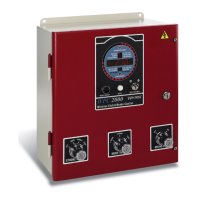WPC 2000 User Manual 1128500
Installation 2-35
Disabling Top-stop in Inch
By default, Inch mode is set so that the ram top-stops whenever the Run/Inch palm buttons on
the Operator Station are pressed and held continuously (see Top-stop in Inch, page 4-9). You
can disable this default setting, allowing the ram to continue cycling in Inch mode as long as
the Run/Inch buttons are depressed. To do so, connect pin #13 on the Main Processor board
to +24 Vdc. You can connect to any convenient terminal that supplies +24 Vdc, such as pin
#9. See Table 2-17, page 2-62. When pin #13 is connected to +24 Vdc, the “Top stop inch
disable” LED on the WPC 2000 Main Processor board is illuminated (see Figure 3-14,
page 3-37 or Figure 3-15, page 3-38).
Wiring a Remote Reset Switch
If you would like to be able to reset the WPC 2000 from a location remote from the enclosure,
the WPC 2000 Main Processor board provides a terminal (i.e., pin #70) for wiring a remote
Reset switch (see Table 2-8 and Figure 2 at the end of the manual). The remote Reset
terminal can be wired to other equipment (e.g., the remote Reset circuit on a SmartPAC 2), or
you can use a simple switch to activate the Reset function.
To wire the remote Reset circuit, connect a wire from pin #70 to a normally open switch.
Connect another wire from the switch to a ground terminal (e.g., pin #54). WPC 2000 is reset
with a momentary connection to ground.
Installing 4-channel Programmable Cam
You connect the cam channels from TB 109 on the WPC 2000 Main Processor board (see
Figure 2-12, page 2-23 or Figure 2-13, page 2-24) to the cam output assembly, which contains
the output relay modules that control the timing signals for your connected equipment. These
relays open and close circuits to your equipment at the crankshaft angles you program (see
Setting Programmable Cams, page 3-33).
Table 2-8. Remote Reset Switch Wiring Connections
Main Processor Board
Pin # Signal
70 Remote Reset input
54 Ground
NON-SAFETY OUTPUTS USED FOR SAFETY FUNCTIONS
Use cams for non-safety functions only, such as convenience in automation. They cannot protect
personnel from a moving hazard.
Failure to comply with these instructions will result in death or serious injury.

